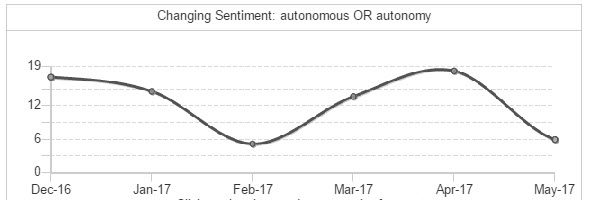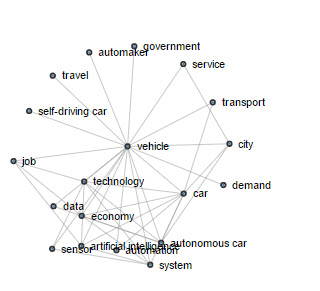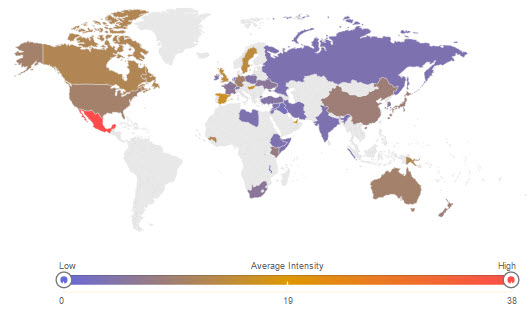
Athena has determined which forecasts should be included in this Trend Alert, and halved the time to produce it. Now it takes just 30 minutes. She can also turn these summaries into slides and audio files very quickly.
- Autonomous Electric Vehicles (A-EVs) will be owned by companies providing Transport as a Service by 2030 which will make up 60 per cent of vehicles on US roads.
- By 2035, 5 million vehicles equipped with fuel cell technology could be in production.
- Peers sitting on the House of Lords Science and Technology Committee have raised concern that self-driving technology will develop drivers unprepared to take back control of a vehicle in certain circumstances.
- Worldwide around 5 percent of all vehicles are expected to be fully autonomous by 2030.
- 3 out of 4 vehicles will be autonomous by 2040.
- A deal with automaker Mercedes-Benz will see its range of vehicles join Uber's ever-expanding fleet of self-driving cars.
- A new report today finds that layering the three vehicle technologies-autonomous, electric and shared-on top of one another could cut carbon emissions 80 percent by 2050 worldwide from a business-as-usual scenario.
- Global sales of fully autonomous vehicles are projected to be 600,000 vehicles in 2025.
- Ninety-five per cent of miles travelled in the US will happen in autonomous vehicles owned by fleets rather than individuals in just over a decade.
- 80% of final mile deliveries will be done by autonomous vehicles within 10 years.
- The Insurance Information Institute expects that it will take 15 to 20 years for truly autonomous vehicles to populate US roads.
- £390 million will be invested into the development of autonomous vehicles in the UK by the end of the current parliament.
- Researchers from the University of the West of England (UWE Bristol) will contribute to a £4.2m pilot scheme that could pave the way for connected and autonomous vehicles to be introduced in airports, hospitals, tourist destinations and shopping centres.
- Autonomous vehicles will hit their tipping point in 2023 in the U.S. and in 2028 in Korea.
- Autonomous vehicles will create a $77 billion industry by 2035.
- In the years 2025 to 2030 will see a convergence of mobility service providers and the deployment of large fleets of autonomous vehicles replacing taxi, bus and trams drivers in cities across the globe.
- Ford's new system for autonomous vehicles could include a sensor programmed to determine whether particular chemicals, such as chemicals used in explosive devices, are present.
- Autonomous vehicles will save more than $1 trillion a year, much of that due to significantly reduced traffic accidents, and those savings will go directly into higher living standards for Americans.
- The market for fully autonomous vehicles will grow to almost $6 billion while partially autonomous vehicles market will reach $36 billion by 2025.
- Critical mass for 100 percent fully autonomous vehicles is at least 10 years (40 quarters) away and will require hundreds of billions of dollars of additional investment to get there.
- Self-driving cars and trucks (autonomous vehicles) could account for as much as 60 percent of US auto sales.
- When autonomous vehicles become commonplace, parking will no longer be required.
- Autonomous vehicles will have disrupted a $100 billion industry -- worldwide parking.
- Connected and autonomous vehicles (CAVs) will transform the lives of six out of every 10 people in the UK.
- Major U.S. automakers will be marketing fully autonomous vehicles by 2020.
- The US will likely be (relatively) quick to adopt the shift to autonomous and connected vehicles due to the wealth base of the population and grounds for innovation already in place.
- 95% of U.S. passenger miles will be served by autonomous electric vehicles owned by companies providing Transportation as a Service.
- A total of 4.7 million autonomous electric vehicles will replace 5.1 million conventional autos sold in the United States.
- BCG estimates that in 2030, total of 4.7 million autonomous electric vehicles will replace 5.1 million conventional autos sold in the US.
- By 2030 more than 5 million conventional cars per year could be replaced by a combination of fully autonomous electric vehicles for urban fleets and partially autonomous cars for personal use.
- Expect autonomous ground-based vehicles to succeed more quickly than flying cars.
- Mobileye expects fully autonomous, mass-produced vehicles will be on the road by 2024 to 2025.
- The demand for autonomous underwater vehicles (AUVs) is expected to grow by 49% in the next four years.
- Auto companies will face wrenching changes as more than 5 million conventional cars are replaced by an estimated 4.7 million autonomous electric vehicles by 2030.
- Elon Musk says most new vehicles will be capable of autonomy inside of ten years.
- The number of passenger vehicles on American roads will drop from 247 million in 2020 to 44 million in 2030.
- Within the next 10 years’ autonomous cars could reverse the trend to free cities from private vehicles, instead flooding the streets with even more cars, undermining public transit, and leaving no space for other uses.
- BCG's conservative estimate is that 23% to 26% of miles driven in the United States could be travelled in shared autonomous electric vehicles by 2030.
- A typical Chicagoan who owns a car and drives 10,000 miles a year could cut the cost of travel from around $1.20 per mile to around 50 cents per mile by using a shared autonomous electric vehicle.
- Every Tesla vehicle will be fully autonomous by 2017.
- A Tesla vehicle will drive in fully autonomous mode from LA to New York City by the end of 2017.
- The residual stock of fossil-based vehicles will take time to clear but 95pc of the kilometres driven by 2030 in the US will be in autonomous EVs for reasons of costs, convenience, and efficiency.
- In 2035, there will be ~20 million L4 / L5 cars sold which is ~32% of new vehicle sales.
- Cadillac will not force drivers to touch the wheel every so often to prove they are ready to take over if the car encounters a situation it cannot handle.
- Expect autonomous ground-based vehicles to succeed more quickly than flying cars.
- A typical Chicagoan who owns a car and drives 10,000 miles a year could cut the cost of travel from around $1.20 per mile to around 50 cents per mile by using a shared autonomous electric vehicle.
- Within the next 10 years’ autonomous cars could reverse the trend to free cities from private vehicles, instead flooding the streets with even more cars, undermining public transit, and leaving no space for other uses.
- Autonomous cars could offer free journeys based on advertising by the middle of the next decade.
- Ford has taken the ambitious step of announcing that it will sell fully autonomous cars without a steering wheel or pedals by 2021.
- South Korea will soon open an 88-acre facility with everything an autonomous car might encounter.
- Autonomous cars will be trialled on Victoria's CityLink and the Monash and Tullamarine freeways in Victoria for two years.
- Google will be looking to find fortune by mining the many gigabytes of data an autonomous car will generate every hour.
- By 2030 more than 5 million conventional cars per year could be replaced by a combination of fully autonomous electric vehicles for urban fleets and partially autonomous cars for personal use.
- Auto companies will face wrenching changes as more than 5 million conventional cars are replaced by an estimated 4.7 million autonomous electric vehicles by 2030.
- Tesla could have a level 4 autonomous system enabled in second generation cars.
- All new models of passenger cars and vans that will be commercialised in Europe be equipped with the automated emergency-Call.
- As many as 925 billion miles (1.5 trillion kilometres) travelled in the U.S. in 2030 will be in shared, self-driving electric cars.
- Tesla cars will be relying on radar more for autopilot as opposed to the sensors.
- US cars will drive themselves coast to coast by 2018.
- A deal with automaker Mercedes-Benz will see its range of vehicles join Uber's ever-expanding fleet of self-driving cars.
- Self-driving cars and trucks (autonomous vehicles) could account for as much as 60 percent of US auto sales.
- Analysts have said self-driving cars will not be in wide use before 2030.
- With driverless cars, Uber and Lyft will not have hard-working drivers keeping 60 percent to 80 percent of the fares.
- A fully autonomous Tesla could be on sale by 2018.
- Autonomous car sales will hit 21 million by 2035.
- Partially autonomous vehicle sales are projected to represent 25% of the automotive market by 2035.
- Global sales of fully autonomous vehicles are projected to be 600,000 vehicles in 2025.
- In 2035, there will be ~20 million L4 / L5 cars sold which is ~32% of new vehicle sales.
- Self-driving cars and trucks (autonomous vehicles) could account for as much as 60 percent of US auto sales.
- Within the next few years, IT systems will be able to make autonomous economic decisions.
- Autonomous systems are one of the eight great technologies that will propel the UK to future growth.
- Tesla could have a level 4 autonomous system enabled in second generation cars.
- Now Apple will focus on developing an autonomous driving system.
- Ford's new system for autonomous vehicles could include a sensor programmed to determine whether chemicals, such as those used in explosive devices, are present.
- Self-driving systems could have profound implications for Amazon.
- The Nvidia system would mean Toyota could have self-driving cars available for sale in the next few years.
- An autonomous BMW could hit the market by 2021.
- The market for fully autonomous vehicles will grow to almost $6 billion while partially autonomous vehicles market will reach $36 billion by 2025.
- Partially autonomous vehicle sales are projected to represent 25% of the automotive market by 2035.
- The global AI market is expected to grow at a compound annual growth rate of greater than 35% by 2022.
- The global connected car market is expected to reach USD144.95 billion by 2020.
- The global autonomous driving market will be worth $83 billion by 2025.
- By 2035, 5 million vehicles equipped with fuel cell technology could be in production.
- Autonomous systems are one of the eight great technologies that will propel the UK to future growth.
- Tesla's autonomous driving technology will allow fleets to run continuous hours.
- Peers sitting on the House of Lords Science and Technology Committee have raised concern that self-driving technology will develop drivers unprepared to take back control of a vehicle in certain circumstances.
- Autonomous navigation is on its way and will get here before 2050.
- The residual stock of fossil-based vehicles will take time to clear but 95pc of the kilometres driven by 2030 in the US will be in autonomous EVs for reasons of costs, convenience, and efficiency.
- By 2030, 95% of U.S. passenger miles travelled will be served by on-demand autonomous electric vehicles owned by fleets.
- Ninety-five per cent of miles travelled in the US will happen in autonomous vehicles owned by fleets rather than individuals in just over a decade.
- Tesla's autonomous driving technology will allow fleets to run continuous hours.
- The new generation of US fighters have been designed with hardware and software that could one day see a single human piloted fighter commanding a fleet of unmanned drones such as autonomous F-16s.
- New research from the Boston Consulting Group finds that 25% of driving in the US could be done by autonomous electric vehicle fleets by 2030.
- A deal with automaker Mercedes-Benz will see its range of vehicles join Uber's ever-expanding fleet of self-driving cars.
- By 2030 more than 5 million conventional cars per year could be replaced by a combination of fully autonomous electric vehicles for urban fleets and partially autonomous cars for personal use.
- Ninety-five per cent of miles travelled in the US will happen in autonomous vehicles owned by fleets rather than individuals in just over a decade.
- BCG's conservative estimate is that 23% to 26% of miles driven in the United States could be travelled in shared autonomous electric vehicles by 2030.
- A typical Chicagoan who owns a car and drives 10,000 miles a year could cut the cost of travel from around $1.20 per mile to around 50 cents per mile by using a shared autonomous electric vehicle.
- As many as 925 billion miles (1.5 trillion kilometres) travelled in the U.S. in 2030 will be in shared, self-driving electric cars.
- 80% of final mile deliveries will be done by autonomous vehicles within 10 years.
- By 2030, 95% of U.S. passenger miles travelled will be served by on-demand autonomous electric vehicles owned by fleets.
- By 2030, 95 percent of U.S. passenger miles travelled will be served by on-demand autonomous electric vehicles (AEVs).
- The dreams of Tesla becoming a player in the RoboTaxi business will likely remain as dreams.
- Tesla will solve computer vision by the end of the year.
- Tesla could have a level 4 autonomous system enabled in second generation cars.
- A fully autonomous Tesla could be on sale by 2018.
- Elon Musk says most new vehicles will be capable of autonomy inside of ten years.
- Within the next few years, IT systems will be able to make autonomous economic decisions.
- The Nvidia system would mean Toyota could have self-driving cars available for sale in the next few years.
- In the next ten-years global socioeconomic shifts will result in larger changes in worker type, available jobs, and ways of working.
- 80% of final mile deliveries will be done by autonomous vehicles within 10 years.
- The Insurance Information Institute expects that it will take 15 to 20 years for truly autonomous vehicles to populate US roads.
- Autonomous cars will be trialled on Victoria's CityLink and the Monash and Tullamarine freeways in Victoria for two years.
- Tesla will solve computer vision by the end of the year.
- In the years 2025 to 2030 will see a convergence of mobility service providers and the deployment of large fleets of autonomous vehicles replacing taxi, bus and trams drivers in cities across the globe.
- The demand for autonomous underwater vehicles (AUVs) is expected to grow by 49% in the next four years.
- Flying taxis could be a reality in the next few years.
- Autonomous vehicles will save more than $1 trillion a year, much of that due to significantly reduced traffic accidents, and those savings will go directly into higher living standards for Americans.
- Critical mass for 100 percent fully autonomous vehicles is at least 10 years (40 quarters) away and will require hundreds of billions of dollars of additional investment to get there.
- Personal drones will absolutely be a thing by the year 2050.
- A typical Chicagoan who owns a car and drives 10,000 miles a year could cut the cost of travel from around $1.20 per mile to around 50 cents per mile by using a shared autonomous electric vehicle.
- Within the next 10-years autonomous cars could reverse the trend to free cities from private vehicles, instead flooding the streets with even more cars, undermining public transit, and leaving no space for other uses.
- By 2030 more than 5 million conventional cars per year could be replaced by a combination of fully autonomous electric vehicles for urban fleets and partially autonomous cars for personal use.
- Self-driving cars and trucks (autonomous vehicles) could account for as much as 60 percent of US auto sales.
- Widespread deployment of autonomous trucks in the US could put the jobs of upwards of three million truckers at risk of technological displacement.
- The new generation of US fighters have been designed with hardware and software that could one day see a single human piloted fighter commanding a fleet of unmanned drones such as autonomous F-16s.
Click here for the latest update and to ‘Respond’ to these emerging issues or Contact Us to ask for a customized report on your interest topic.
Sentiment Analysis
Autonomy sentiment is very positive. There are few negatives seen with autonomous vehicles but most forecasts report positive potential future impacts.

Topic map
Advances in autonomous ground transport dominates the near future but air, sea and space vehicles are likely to be pilotless too in the medium term.

Heat map
North America, China, Australia and some parts of Europe have the biggest opportunities for autonomous vehicles right now.

Keep up to date: You can stay bang up to date on this topic here. Or ask us to set-up private topics for you (clients only).
Time to complete: Athena read and found 2,743 forecasts to allow us to produce this summary in 30 minutes.